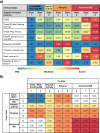AI-driven reclassification of multiple sclerosis progression
- PMID: 40835969
- PMCID: PMC12532606
- DOI: 10.1038/s41591-025-03901-6
AI-driven reclassification of multiple sclerosis progression
Abstract
Multiple sclerosis (MS) affects 2.9 million people. Traditional classification of MS into distinct subtypes poorly reflects its pathobiology and has limited value for prognosticating disease evolution and treatment response, thereby hampering drug discovery. Here we report a data-driven classification of MS disease evolution by analyzing a large clinical trial database (approximately 8,000 patients, 118,000 patient visits and more than 35,000 magnetic resonance imaging scans) using probabilistic machine learning. Four dimensions define MS disease states: physical disability, brain damage, relapse and subclinical disease activity. Early/mild/evolving (EME) MS and advanced MS represent two poles of a disease severity spectrum. Patients with EME MS show limited clinical impairment and minor brain damage. Transitions to advanced MS occur via brain damage accumulation through inflammatory states, with or without accompanying symptoms. Advanced MS is characterized by moderate to high disability levels, radiological disease burden and risk of disease progression independent of relapses, with little probability of returning to earlier MS states. We validated these results in an independent clinical trial database and a real-world cohort, totaling more than 4,000 patients with MS. Our findings support viewing MS as a disease continuum. We propose a streamlined disease classification to offer a unifying understanding of the disease, improve patient management and enhance drug discovery efficiency and precision.
© 2025. The Author(s).
Conflict of interest statement
Competing interests: A.J.T. receives fees from being Co-Chair, UCL-Eisai Steering Committee drug discovery collaboration; Member, National Multiple Sclerosis Society (NMSS) Research Programs Advisory Committee; Clinical Trials Committee, Progressive MS Alliance; Board Member, European Charcot Foundation; Editor in Chief, Multiple Sclerosis journal; and Editorial Board Member, Lancet Neurology. He receives no fees from being Chair (Scientific Ambassadors), ‘Stop MS’ Appeal Board, UK MS Society; research & academic counsellor, Fundació Privada Cemcat; and Ambassador, European Brain Council. A.J.T. additionally holds a patent for the MSIS-29 Impact Scale. X.M. has received speaking honoraria and travel expenses for participation in scientific meetings and has been a steering committee member of clinical trials or has participated in advisory boards of clinical trials in the past years with AbbVie, Actelion, Alexion, Biogen, Bristol Myers Squibb/Celgene, EMD Serono, Genzyme, F. Hoffmann-La Roche, Immunic, Janssen Pharmaceuticals, MedDay Pharmaceuticals, Merck, Mylan, NervGen, Novartis, Sandoz, Sanofi-Genzyme, Teva, TG Therapeutics, EXCEMED, the MS International Federation and the NMSS. F.D.L. reports as sources of funding for research: Novartis, Actelion, Biogen, Sanofi, NMSS, National Institutes of Health and Brainstorm Cell Therapeutics; consulting agreements/advisory boards/data and safety monitoring board: Biogen, EMD Serono, Novartis, Teva, Actelion/Janssen, Sanofi/Genzyme, Acorda, Roche/ Genentech, MedImmune/Viela Bio, Receptos/Celgene/Bristol Myers Squibb, TG Therapeutics, MedDay Pharmaceuticals, Atara Biotherapeutics, Mapi Pharma, Apitope, Orion Biotechnology, Brainstorm Cell Therapeutics, Jazz Pharmaceuticals, GW Pharma, Mylan, Immunic, Population Council, Avotres, Neurogene, Banner Life Sciences, LabCorp, Entelexo Biotherapeutics and NeuraLight; stock options: Avotres and NeuraLight; and speaker: Sanofi (non-promotional). L.K.’s institution (University Hospital Basel) has received the following exclusively for research support: steering committee, advisory board and/or consultancy fees (Biogen, EMD Serono Research and Development, Genentech, Janssen, Novartis, Clene Nanomedicine, Bayer, Bristol Myers Squibb, Celltrion, Eli Lilly (Suisse) SA, EMD Serono Research and Development, Galapagos NV, Kiniksa Pharmaceuticals, Merck Healthcare AG, Minoryx and Santhera, Neurostatus UHB AG, Roche, Sanofi, Santhera Pharmaceuticals, Shionogi BV, Wellmera AG and Zai Lab); speaker fees (Bristol Myers Squibb, Janssen, Novartis, Roche and Sanofi); grants (European Union, Innosuisse, Merck Healthcare AG, Novartis and Roche); and testimony (Df-mp Mplina & Pohlman). D.L.A. reports consulting fees from Biogen, Biohaven, Bristol Myers Squibb, Eli Lilly, EMD Serono, Find Therapeutics, Frequency Therapeutics, GlaxoSmithKline, Idorsia Pharmaceuticals, Kiniksa Pharmaceuticals, Merck, Novartis, Race to Erase MS, Roche, Sanofi-Aventis, Shionogi and Xfacto Communications as well as an equity interest in NeuroRx. R.A.B. has served as a consultant for AstraZeneca, Biogen, EMD Serono, Genzyme, Genentech, Novartis and VielaBio. He also receives research support from Biogen, Genentech and Novartis. H.W. has received honoraria for being a member of scientific advisory boards for Biogen, Evgen, Genzyme, MedDay Pharmaceuticals, Merck Serono, Novartis, Roche Pharma AG and Sanofi-Aventis as well as speaker honoraria and travel support from Alexion, Biogen, Cognomed, F. Hoffmann-La Roche, Gemeinnützige Hertie-Stiftung, Merck Serono, Novartis, Roche Pharma AG, Genzyme, Teva and WebMD Global. H.W. is also acting as a paid consultant for AbbVie, Actelion, Biogen, IGES, Johnson & Johnson, Novartis, Roche, Sanofi-Aventis and the Swiss Multiple Sclerosis Society. His research is funded by the German Ministry for Education and Research (BMBF), the Deutsche Forschungsgemeinschaft (DFG), the Else Kröner Fresenius Foundation, the European Union, the Hertie Foundation, the NRW Ministry of Education and Research, the Interdisciplinary Center for Clinical Studies (IZKF) Muenster and RE Children’s Foundation, Biogen, GlaxoSmithKline, Roche Pharma AG and Sanofi-Genzyme. D.A.H., P.A., G.G., W.S., E.F., L.G. and B.C.K. are employees of Novartis. H.G., Y.S., S.G., T.E.N. and C.C.H. are current employees of the Big Data Institute, which received funding from Novartis to collaborate on AI in medicine, including the work presented here. C.B. and S.P.T. are employees of Roche. A.B. received speaker honoraria from Amicus Therapeutics and Biogen. T.E.N. received consulting fees from Perspectum Ltd.
Figures








References
-
- MS International Federation. Atlas of MS. https://www.atlasofms.org
-
- Lublin, F. D. & Reingold, S. C. Defining the clinical course of multiple sclerosis: results of an international survey. Neurology46, 907–911 (1996). - PubMed
-
- Rotstein, D. & Montalban, X. Reaching an evidence-based prognosis for personalized treatment of multiple sclerosis. Nat. Rev. Neurol.15, 287–300 (2019). - PubMed
MeSH terms
LinkOut - more resources
Full Text Sources
Medical

